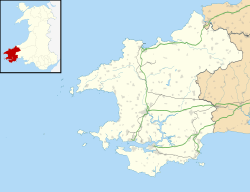| RNAS Lawrenny Ferry | |
|---|---|
| Lawrenny, Pembrokeshire in Wales | |
 Lawrenny Quay, the Fleet Air Arm flew seaplanes from this point during WW2 | |
| Site information | |
| Type | Seaplane and Flying boat station |
| Owner | Admiralty |
| Operator | Royal Navy |
| Controlled by | Fleet Air Arm |
| Location | |
| Coordinates | 51°43′5″N004°52′40″W / 51.71806°N 4.87778°W |
| Site history | |
| Built | 1941 |
| In use | 1943 - 1946 |
| Battles/wars | European theatre of World War II |
Royal Naval Air Station Lawrenny Ferry(RNAS Lawrenny Ferry, also known as HMS Daedalus II) was a former Royal Naval Air Station located near Lawrenny, Pembrokeshire, Wales. It was operational from 1941 to 1946, serving the Royal Navy from 1941 to 1943 after which it was placed into Care & Maintenance status.
Contents
- History
- Royal Navy operations
- Advance seaplane training squadron
- Station commanders
- Previous units
- See also
- References
- Citations
- Bibliography
The station was situated 3 miles (4.8 km) northeast of Pembroke Dock, on the north side of the junction where the river Cresswell and river Carew meet the Eastern Cleddau, the northern extension of Milford Haven. [1]

